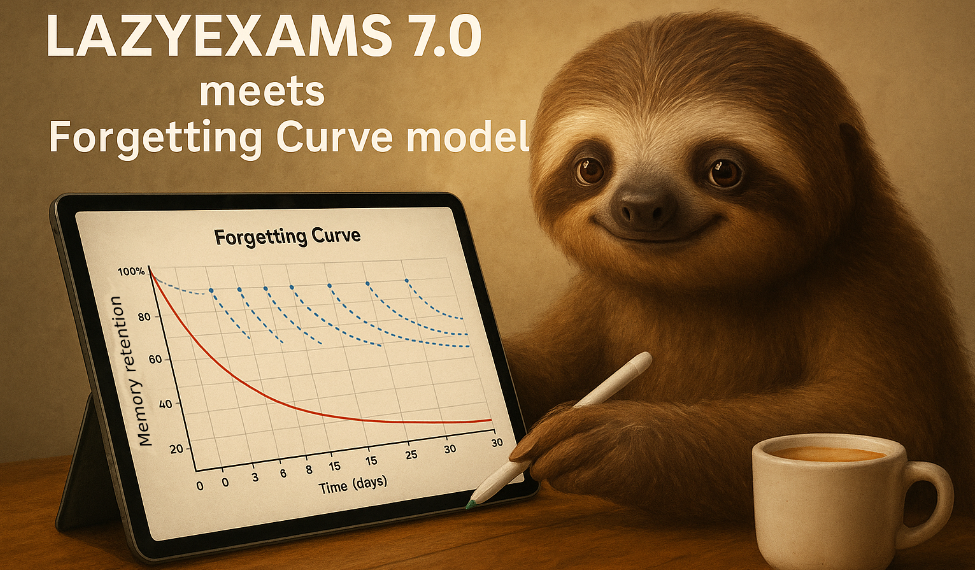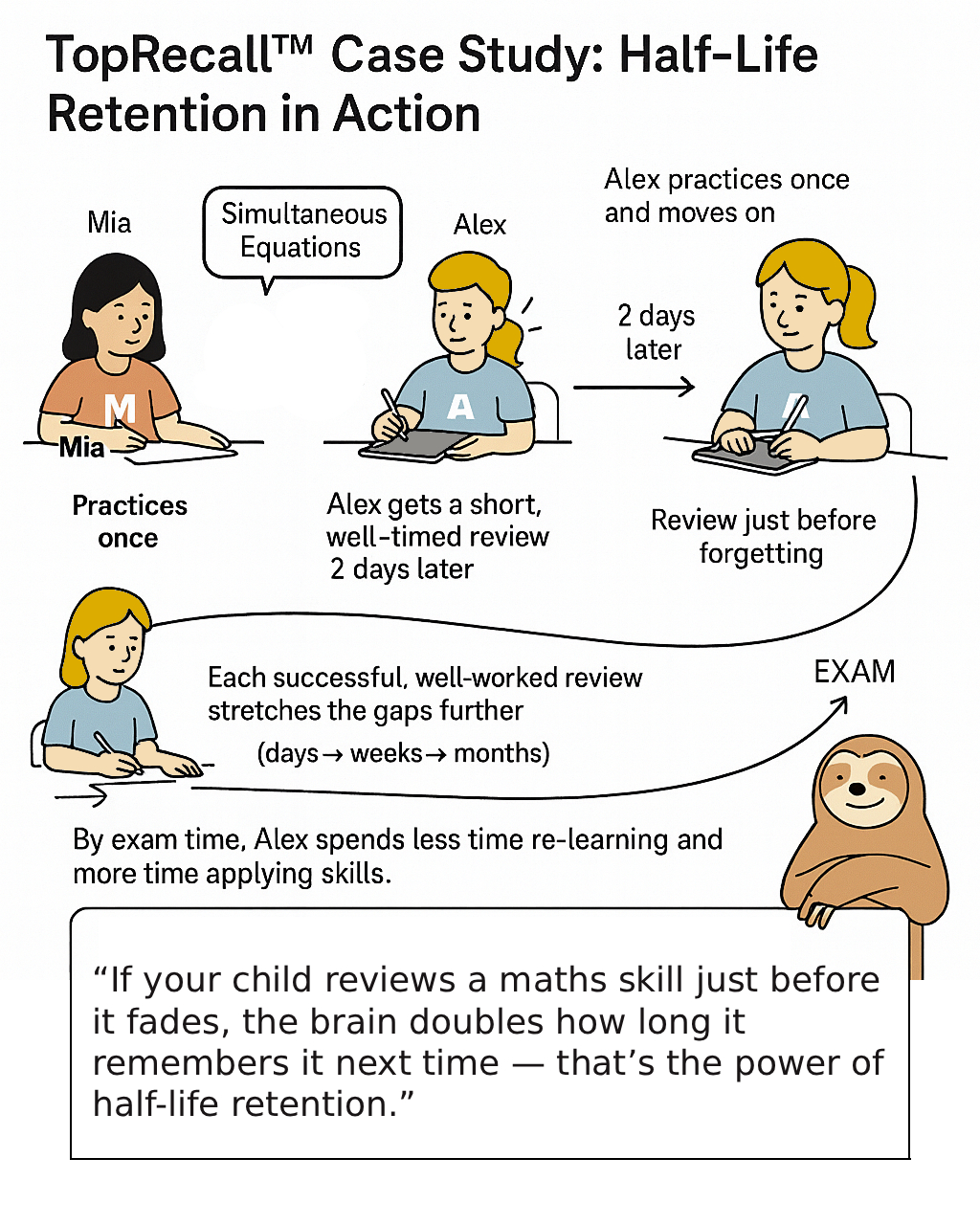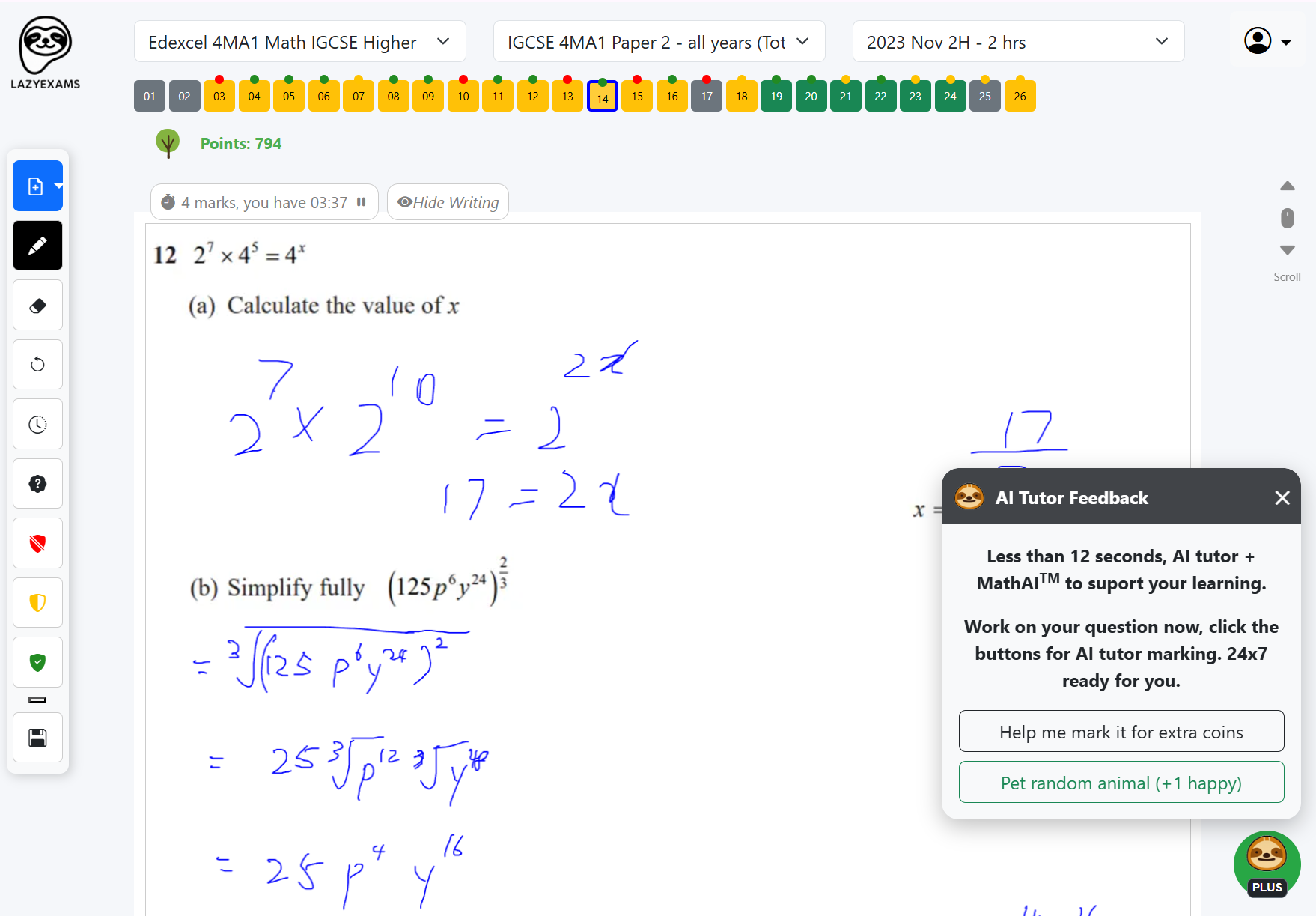LazyExams 7.0 with TopRecall™ — Launching December 2025

We’re finalising TopRecall™ — our patent-pending, AI-guided review engine that blends AI Marking with evidence-based spacing to help students retain Maths for longer with less stress.
TopRecall™ learns from every AI-marked attempt (no extra steps needed) and times the next short review when it’s most helpful. Keep practising as normal — your child’s private memory profile builds in the background.
Start now: Upgrade to PLUS so TopRecall™ can begin capturing learning signals today. When LazyExams 7.0 goes live in December, your existing data will power smarter, calmer revision.
TopRecall™ focuses on step-aware AI signals and humane scheduling to guide when and what to practise. It’s designed to be transparent, interpretable, and hard to clone without our data pipeline and timing logic. Learn how we protect the core.
TopRecall™ Case Study: Half-Life Retention in Action
Two students, same topic (simultaneous equations), same day.
Mia practises once and moves on. Alex gets a short, well-timed TopRecall™ review two days later — right before she was likely to forget. That tiny nudge extends Alex’s “remembering window.”
- Next review for Alex is scheduled when she’s ~80–85% likely to recall — not too early, not too late.
- Each successful, well-worked review stretches the gap further (days → weeks → months).
- By exam time, Alex spends less time re-learning and more time applying skills.

One-liner: “Review just before forgetting — and the brain keeps it for longer next time.”
ResearchTopRecall™: A Precision-Spaced Practice Engine for GCSE/IGCSE Maths (PLUS)
Integrating interpretable spacing with AI-quality marking in LazyExams
Summary for Parents
Students remember best when short reviews happen just before forgetting. TopRecall™ uses AI Marking to read the quality of each attempt and quietly schedules the next quick check at the right time. That means fewer random worksheets, less cramming, and steadier progress.
Our design is informed by public scholarship on spacing and retrieval practice (e.g., foundational forgetting/spacing work associated with Ebbinghaus, and modern labs on spacing and retrieval practice). These sources inform our approach; they are not endorsements.
What It’s Called
TopRecall™ — a personalised, interpretable review engine that adapts timing from AI-marked work.
What It Uses
Signals from AI Marking (accuracy, reasoning steps, confidence, difficulty) to inform when and what to revisit.
Why Parents Like It
Short, well-timed practice. Clear colours. Less pressure. Progress that sticks for exams.
How LazyExams Works with TopRecall™
For each student and each question, TopRecall™ maintains an interpretable sense of how stable that skill seems. Every AI-marked attempt contributes multiple signals (e.g., score, steps/working quality, optional confidence, difficulty). Strong evidence pushes the next review further out; weaker evidence brings it a bit closer — focusing time where it helps most.
Concept summary:
• Each question builds a personal “stability” measure.
• AI Marking signals guide the timing of the next short review.
• Intervals grow naturally as evidence of mastery accumulates.
• The plan stays small, achievable, and specific to the child.
From AI Marking to Learning Insights
AI Marking looks beyond right/wrong. It values well-explained steps and moderates rushed guessing. TopRecall™ merges these signals into a single learning strength that sets “when next” for that topic. Strong topics drift to long intervals; wobbly ones return for quick, confidence-building refreshers.
Personalisation Across Students and Topics
No two learners forget at the same pace. TopRecall™ adapts per student, per topic strand (Number, Algebra, Geometry, etc.), and per question. The experience stays fair, transparent, and tailored — not one-size-fits-all.
Keeping Workloads Balanced
Daily practice lists are capped so revision stays humane. Items are prioritised by urgency and spread across strands. Colours make it clear: Green (stable), Yellow (soon), Red (revive). Turning red to green earns small wins and momentum.
Stable (Green)
Secure and growing. Occasional check-ins only.
Soon (Yellow)
Light review soon to keep it fresh.
Revive (Red)
Quick revisit restores confidence and strength.
Why an Interpretable Approach
- Transparent: Students can see why something is due.
- Adaptive: Intervals stretch as evidence accumulates.
- Auditable: Few inputs, explainable decisions.
- Motivating: Clear colours and visible wins.
Study Design (Evaluation Outline)
We plan classroom-scale evaluations comparing business-as-usual revision against TopRecall™-guided scheduling. Outcomes include delayed retention, strand-level transfer, and marks-per-minute efficiency. Analyses will use appropriate mixed-effects models, with de-identified data and school-approved safeguards.
Planned metrics:
• Retention after delays on previously practised skills
• Near transfer within the same category
• Efficiency (marks gained per minute)
• Engagement and pacing over time
What Parents Can Expect
- Short, balanced daily sets that fit busy schedules.
- Revision that targets the child’s actual needs — not random worksheets.
- Visible progress with simple colours and small rewards.
- Fewer repeats of mastered material; more focus where it counts.
Limitations and Safeguards
Every child is unique, so TopRecall™ keeps adjusting. It values clear working, moderates guessing, and caps daily workloads. Teachers and parents can monitor and align with curriculum pacing. The aim is durable understanding, not last-minute cramming.
TopRecall™ Patent-Pending (Public Summary)
Our protection focuses on how step-level, AI-graded Maths attempts are converted into multi-signal learning strength and humane, load-balanced scheduling. We publicly share the benefits and high-level design while keeping the specific pipeline and update rules proprietary.
References (Public Scholarship)
- Foundational forgetting/spacing work associated with Ebbinghaus (1885).
- Modern research communities studying spacing, retrieval practice, and durable learning.
